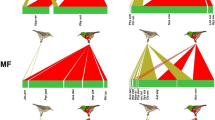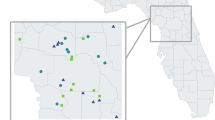Abstract
Various artificial diets have been used for rearing imported fire ants; however most of these diets include insect supplements. This study was designed to examine growth of red imported fire ant colonies (Solenopsis invicta Buren) on four artificial diets: a chemically undefined “oligidic” predator diet, two partly defined “meridic” diets utilized by Bhatkar and Whitcomb (Florida Entomol. 53: 229–232, 1970) and Dussutour and Simpson (Insect. Soc. 55: 329–333, 2008) for Solenopsis fire ants and Rhytido-ponera ants, respectively, and finally a completely chemically defined “holidic” diet utilized by Straka and Feldhaar (Insect. Soc. 54: 100–104, 2007a, Insect. Soc. 54: 202, 2007b Erratum) for carpenter ants. Crickets and sugar water were used as a standard diet. After 6 weeks, fire ant colonies fed crickets and sugar water were healthy and had grown considerably. In contrast, colonies fed the artificial diets showed little or no growth demonstrating that these diets are not suitable for rearing healthy fire ant colonies. Nevertheless, the holidic or entirely synthetic Straka diet may provide a suitable basis for further studies of fire ant dietary requirements because it resulted in modest production of all brood stages. We advise caution in using diets that mix sugar and protein into a single “all in one” diet because workers and brood have differing dietary requirements.


Similar content being viewed by others
References
Alloway T.M., Leighl A. and Ryckman D. 1991. Diet does not affect intercolonial fighting in Leptothoracine ants. Insect. Soc. 38: 189–193
Bailey L. 1952. The action of the proventriculus of the worker honeybee, Apis-mellifera L. J. Exp. Biol. 29: 310–327
Banks W.A., Lofgren C.S., Jouvenaz D.P., Stringer C.E., Bishop P.M., Williams D.F., Wojcik D.P. and Glancey B.M. 1981. Techniques for collecting, rearing, and handling imported fire ants. USDA, SEA, AATS-S-21, 9 pp
Bhatkar A.P. and Whitcomb W.H. 1970. Artificial diet for rearing various species of ants. Florida Entomol. 53: 229–232
Blüthgen N. and Feldhaar H. 2009. Food and shelter: how resources influence ant ecology. In: Ant Ecology (Lach L., Parr C. and Abbott K., Eds), Oxford University Press, Oxford, UK, pp 115–136
Buschinger A. and Pfeifer E. 1988. Effects of nutrition on brood production and slavery in ants (Hymenoptera, Formicidae). Insect. Soc. 35: 61–69
Cassill D.L. and Tschinkel W. 1999. Regulation of diet in the fire ant, Solenopsis invicta. J. Insect Behav. 12: 307–328
Cook S.C., Eubanks M.D., Gold R.E. and Behmer S.T. 2010. Colony-level macronutrient regulation in ants: mechanisms, hoarding and associated costs. Anim. Behav. 79: 429–437
Dadd R.H. 1970. Arthropod Nutrition. In: Chemical Zoology. Arthro-poda Part A, vol 5 (M. Florkin and B.T. Scheer, Eds), Academic Press, New York, pp 35–96
Dougherty E.C. 1959. Introduction to axenic culture of invertebrate metazoa: A goal. Ann. N.Y. Acad. Sci. 77: 27–54
Dussutour A. and Simpson S.J. 2008. Description of a simple synthetic diet for studying nutritional responses in ants. Insect. Soc. 55: 329–333
Dussutour A. and Simpson S.J. 2009. Communal nutrition in ants. Curr. Biol. 19: 740–744
Dussutour A. and Simpson S.J. 2012. Ant workers die young and colonies collapse when fed a high-protein diet. Proc. R. Soc. Biol. Sci. 279: 2402–2408
Eisner T. and Happ G.M. 1962. The infrabuccal pocket of a formicine ant: a social filtration device. Psyche 69: 107–116
Fielde A.M. 1904. Portable Ant-Nests. Biol. Bull. 7: 215–220
Gavilanez-Slone J.M. and Porter S.D. 2013. Colony growth of two species of Solenopsis fire ants (Hymenoptera: Formicidae) reared with crickets and beef liver. Florida Entomol. 96: 1482–1488
Glancey B.M., Vander Meer R.K., Glover A., Lofgren C.S. and Vinson S.B. 1981. Filtration of microparticles from liquids ingested by the red imported fire ant, Solenopsis invicta Buren. Insect. Soc. 28: 395–401
Hintze J. 2001. NCSS 2001. NCSS, LLC., Kaysville, Utah
Hölldobler B. and Wilson E.O. 1990. The Ants. Harvard University Press, Cambridge, Mass
Howard D.F. and Tschinkel W.R. 1981. The flow of food in colonies of the fire ant, Solenopsis invicta: a multifactorial study. Physiol. Entomol. 6: 297–306
Kaspari M., Yanoviak S.P. and Dudley R. 2008. On the biogeography of salt limitation: a study of ant communities. Proc. Natl Acad. Sci. USA 105: 17848–17851
Keller L., Cherix D. and Ulloa Chacón P. 1989. Description of a new artificial diet for rearing ant colonies as Iridomyrmex humilis, Monomorium pharaonis and Wasmannia auropunctata (Hymenoptera; Formicidae). Insect. Soc. 36: 348–352
Khan A.R., Green H.B. and Brazzel J.R. 1967. Laboratory rearing of the imported fire ant. J. Econ. Entomol. 60: 915–917
Lapointe S.L., Evens T.J. and Niedz R.P. 2008. Insect diets as mixtures: optimization for a polyphagous weevil. J. Insect Physiol. 54: 1157–1167
Lubertazzi D., Aliberti Lubertazzi M.A., McCoy N., Gove A.D., Majer J.D. and Dunn R.R. 2010. The ecology of a keystone seed disperser, the ant Rhytidoponera violacea. J. Insect Sci. 10: 1–15
Macom T.E. and Porter S.D. 1995. Food and energy requirements of laboratory fire ant colonies (Hymenoptera: Formicidae). Environ. Entomol. 24: 387–391
Mankowski M.E. 2002. Biology of the carpenter ants Camponotus vicinus (Mayr) and Camponotus modoc (Wheeler) in western Oregon. Thesis/Dissertation
Mankowski M.E. and Morrell J.J. 2004. Yeasts associated with the infrabuccal pocket and colonies of the carpenter ant Camponotus vicinus. Mycologia 96: 226–231
NCSS L. 2001. Number Cruncher Statistical Systems. Kaysville, Utah
Oi D.H. 2006. Effect of mono- and polygyne social forms on transmission and spread of microsporidium in fire ant populations. J. Invertebr. Pathol. 92: 146–151
Pamilo P., Crozier R.H. and Fraser J. 1985. Inter-nest interactions, nest autonomy, and reproductive specialization in an Australian arid-zone ant, Rhytidoponera sp. 12. Psyche 92: 217–236
Petralia R.S. and Vinson S.B. 1978. Feeding in the larvae of the imported fire ant, Solenopsis invicta: behavior and morphological adaptations. Ann. Entomol. Soc. Am. 71: 643–648
Petti J.M. 1998. The structure and function of the buccal tube filter in workers of the ant species Solenopsis invicta, Camponotus floridanus, Monomorium pharaonis. M.S. Thesis, University of Florida, Gainesville, FL, 132 p
Porter S.D. 1988. Impact of temperature on colony growth and developmental rates of the ant, Solenopsis invicta. J. Insect Physiol. 34: 1127–1133
Porter S.D. 1989. Effects of diet on the growth of laboratory fire ant colonies (Hymenoptera: Formicidae). J. Kansas Entomol. Soc. 62: 288–291
Porter S.D. and Tschinkel W.R. 1985. Fire ant polymorphism: the ergonomics of brood production. Behav. Ecol. Sociobiol. 16: 323–336
Resasco J. 2013. Environmental changes affecting dominant ant species. Environmental changes affecting dominant ant species. University of Florida, Gainesville
Sorensen A.A., Busch T.M. and Vinson S.B. 1983. Factors affecting brood cannibalism in laboratory colonies of the imported fire ant, Solenopsis invicta Buren (Hymenoptera: Formicidae). J. Kansas Entomol. Soc. 56: 140–150
Sorensen A.A. and Vinson S.B. 1981. Quantitative food distribution studies within laboratory colonies of the imported fire ant, Solenopsis invicta Buren. Insect. Soc. 28: 129–160
Sorvari J. and Haatanen M.-K. 2012. Aspartame-based sweetener as a strong ant poison: Falsifying an urban legend? Sociobiology 59: 343
Straka J. and Feldhaar H. 2007a. Development of a chemically defined diet for ants. Insect. Soc. 54: 100–104
Straka J. and Feldhaar H. 2007b. Development of a chemically defined diet for ants (Erratum). Insect. Soc. 54: 202
Tennant L.E. and Porter S.D. 1991. Comparison of diets of two fire ant species (Hymenoptera: Formicidae): solid and liquid components. J. Entomol. Sci. 26: 450–465
Valles S.M. and Porter S.D. 2013. Procedures to mitigate the impact of Solenopsis invicta virus 3 in fire ant (Hymenoptera: Formicidae) rearing facilities. Florida Entomol. 96: 252–254
Vanderzant E.S. 1974. Development, significance, and application of artificial diets for insects. Annu. Rev. Entomol. 19: 139–160
Vinson S.B. 1968. The distribution of an oil, carbohydrate, and protein food source to members of the imported fire ant colony. J. Econ. Entomol. 61: 712–714
Vinson S.B. and Greenberg L. 1986. The biology, physiology, and ecology of imported fire ants. In: Economic Impact and Control of Social Insects (Vinson S.B., Ed), Praeger, New York. pp 193–226
Vogt J.T. 2003. Attractiveness and effectiveness of an artificial diet fed to hybrid imported fire ants, Solenopsis invicta x richteri (Hymenoptera: Formicidae). Florida Entomol. 86: 456–459
Weeks R.D., Jr., Wilson L.T., Vinson S.B. and James W.D. 2004. Flow of carbohydrates, lipids, and protein among colonies of polygyne red imported fire ants, Solenopsis invicta (Hymenoptera: Formicidae). Ann. Entomol. Soc. Am. 97: 105–110
Williams D.F., Lofgren C.S. and Lemire A. 1980. A simple diet for rearing laboratory colonies of the red imported fire ant. J. Econ. Entomol. 73: 176–177
Williams D.F., Vander Meer R.K. and Lofgren C.S. 1987. Diet-induced nonmelanized cuticle in workers of the imported fire ant Solenopsis invicta Buren. Arch. Insect Biochem. Physiol. 4: 251–259
Winston M.L. 1991. The Biology of the Honey Bee. Harvard University Press, Cambridge, MA
Acknowledgments
The authors appreciate the assistance provided by Darrell Hall (CMAVE, Gainesville, Florida) in helping with processing samples and feeding the colonies. We thank Ulrich Bernier, Alisa Huffaker, Rodney Nagoshi, Peter Teal, Steven Valles, Robert Vander Meer (all CMAVE), and Aaron Hirko (SFC, Gainesville) for sharing chemicals needed for the diets. We thank Robert Vander Meer (CMAVE), Deby Cassill (USF, Tampa, Florida), Andrea Dussutour (CNRS, Toulouse, France) and an anonymous reviewer for helpful comments. Mention of trade names or commercial products in this article is solely for the purpose of providing specific information and does not imply recommendation or endorsement by the U.S. Department of Agriculture.
Author information
Authors and Affiliations
Corresponding author
Electronic supplementary material
Below is the link to the electronic supplementary material.
Rights and permissions
About this article
Cite this article
Gavilanez-Slone, J., Porter, S.D. Laboratory fire ant colonies (Solenopsis invicta) fail to grow with Bhatkar diet and three other artificial diets. Insect. Soc. 61, 281–287 (2014). https://doi.org/10.1007/s00040-014-0353-7
Received:
Revised:
Accepted:
Published:
Issue Date:
DOI: https://doi.org/10.1007/s00040-014-0353-7




